Glimpses through the Fog
Multiplying Movements

Astonishing Progress
See, I am doing a new thing!
Now it springs up;
do you not perceive it?
Isaiah 43:19

Glimpsing cows through a fog on an unfamiliar road, one might wonder: “Just how many more cows are there?”
In the mid-1970s, many were stirred to pray for and go to unreached people groups (UPGs) and the 10/40 Window. Despite isolated glimpses of Acts-like movements, not much progress was visible. About 7,000 UPGs remain unreached.[1] Now, credible reports of multiplying movements suggest change is coming, and quickly!
Since 1995, less than 25 years ago, multiplying movements of small, reproducing churches have brought 50 million to faith in Jesus and equipped these new disciples to share their faith and disciple others. And the pace shows no sign of slowing.
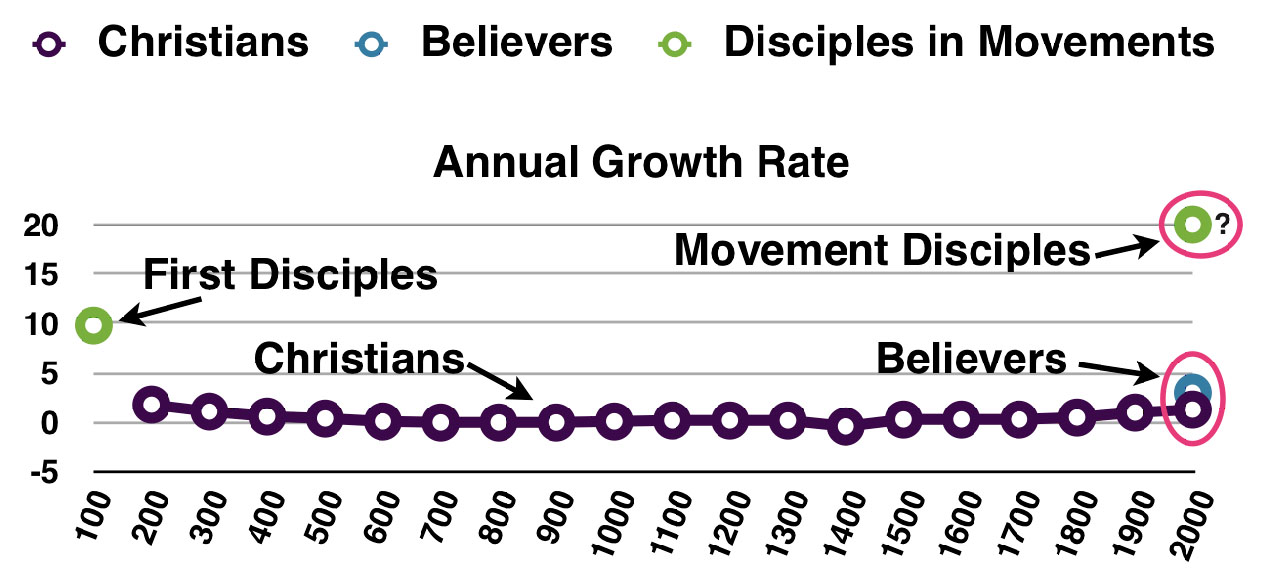
The lifting fog
In late 2015, researchers estimated about 100 movements globally, consistent with movements verified by on-site visits. By late 2016, this estimate had risen to roughly 130. In May of 2017, Kent Parks reported more than 150 movements to the Lausanne network.[2]
Then in mid-2017, formation of the 24:14 Coalition[3] deepened trust between movement leaders and researchers, and many shared their data for the first time. Credible organizations and networks reported approximately 2,500 movement engagements,[4] including nearly 500 movements[5] that had produced millions of new disciples. As 2017 ended, the count was nearly 650 movements with 50 million disciples!
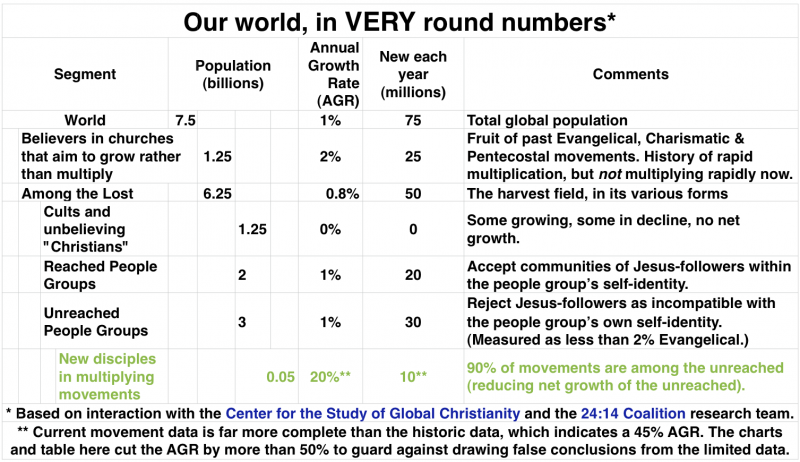
Why the fog, anyway?
Overlapping terms lead many to think of a church planting movement as just faster church planting. In fact movements and church planting are fundamentally different. Church planters typically pour vast energy into turning strangers into “family.” Multiplying movements focus instead on sowing God’s word into groups with pre-existing relationships, like the oikos (households) of the New Testament.
As in the first century, movement ekklesia[6] multiply rapidly without dedicated buildings. Those inclined to associate church with buildings can thus easily conclude movements aren’t real.
A few large, well-known, older movements go back 20 years or more, and have slowed in growth as they got bigger. However most movements are new, smaller, and growing much more rapidly.
Mission leaders have shared these reports in confidence, to guide collaborative strategy. They have good reason to restrict their reports to supporters and trusted colleagues:
Well-intentioned outsiders can quickly derail a movement.
Outside funding has killed off many budding movements.
Unwanted attention increases persecution of movements.
About 15 known movements have fizzled to date, but most continue growing exponentially, and some are multiplying to additional UPGs.
Movements multiply ekklesia faster than they can be readily counted, and terminology and methods for tracking such movements are still emerging. Where on-site verification by a visiting team is impractical, researchers seek detailed reports and independent confirmation.
The fog hasn’t fully lifted, so we don’t yet know what we don’t yet know. But the implications of these reports are truly…
Astonishing!
By late 2017, credible reports supported this new expanding awareness:
In 1995: at least 5 full movements with 15,000 new disciples.
In 2000: at least 10 movements with 100,000 new disciples.
In 2017: at least 645 movements with 47,500,000 new disciples!
And at least 90% of these movements are among UPGs!
These movements are present mostly in multiple locations in a few hundred widely distributed UPGs—in 149 of 234 countries (60%), and nearly 80% of Joshua Project’s people group clusters.
Thus, in recent decades, at least 1% of the global population of UPGs have become—not just believers—but obedience-oriented disciples in rapidly multiplying ekklesia!
Thousands of movement engagements have been reported, but for this count of movements the 24:14 Coalition research team includes only credible reports of Level 5 or higher movements.[7]
Thousands more movements are still needed, yet there are many reasons to hope expectantly for their continued multiplication.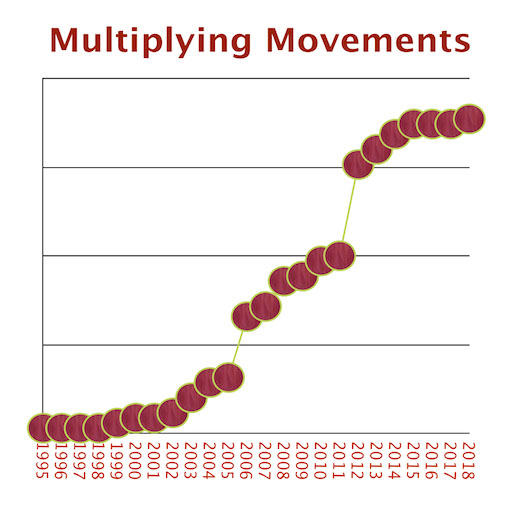
|
|
|
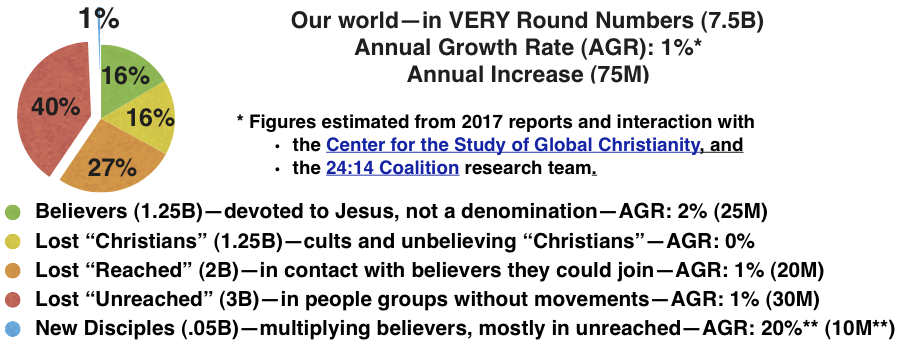
Hindrances and Accelerators
Various factors can hinder the growth of individual movements:
- As movements expand, their growth rate usually declines.
- Saturation of population segments inevitably slows movements.
- Global attention could increase persecution and other inhibitors.
- Relocation and/or moral failure can remove key leaders.
- Visible churches planted by extraction can inhibit movements.[8]
Yet the global movement count will likely keep growing, through:
- Further review of movement reports not initially deemed credible.
- Spirit-led progression of existing engagements into movements.
- Church planters learning to how to pursue movements.
- Traditional (visible) churches learning to start movements.
- Mobilization of more laborers to pursue movements.
- Increasingly effective movement training, with guided experience.
- Unprecedented learning from each others’ successes and failures.
- Spontaneous spread of movements to new peoples and places.
- Intentional multiplication of existing movements.
- Multiplied believers praying explicitly for movements.
- Further discovery of what God is already doing.
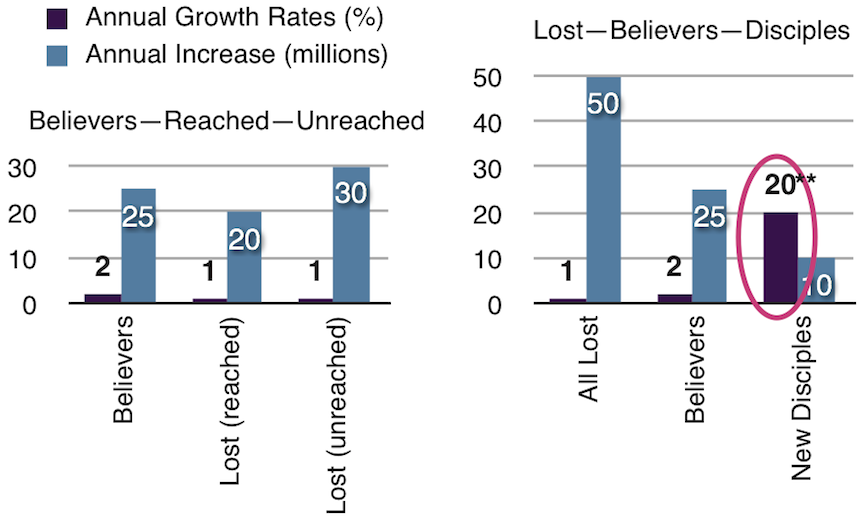
Common characteristics of movement ekklesia[9]
In movements, ekklesia typically …
- Aim to bless and disciple families/social units more than individuals.
- Raise up and equip natural leaders from within existing groups.
- Focus more on obeying Jesus than on accumulating knowledge.
- Disciple more by God-led discovery study than experts teaching.
- Cultivate maturity more through loving obedience than knowledge.
- Meet in private homes and public venues more than owned buildings.
- Average fewer than 20 participants in regular, interactive gatherings.
- Aim to multiply new ekklesia rather than grow in size.
- Employ simple patterns each disciple can facilitate and replicate.
- Involve disciples more in ministering than in receiving ministry.
- Work toward multiple new generations (not just daughter churches).
- Spread more through relational networks than attracting strangers.
- Prove more stable than churches of gathered strangers.
- Are invisible at first to outsiders and the surrounding community.
Historical perspective
Most believers since the first century have had no option but to live provincial lives—without opportunity to see the unfolding progression of God’s global purpose, or grasp our place in it. We have the unprecedented ability to view recent developments with historical perspective to anticipate what lies ahead.
Christ’s ekklesia was birthed in a prayer meeting—Pentecost. From that event His global ekklesia experienced double digit annual growth (10%+) only once—from 33–50 AD.[10] In that rapid growth, Christ’s ekklesia had no written scriptures or buildings, instead they had just…
Jesus’ ministry, training model and global commission,
daily prayer and fellowship with one another,
the empowering of the Holy Spirit, and
their testimony of Jesus’ life and work in their lives.
Yet by 400AD the church was centered in dedicated buildings and the annual growth of Christians had slowed to less than half a percent (.5%), where it stayed until the 1800s.
Even two hundred years after Martin Luther launched the Reformation, the growth of global Christianity remained below 0.5%. Then, in 1727, a band of 300 squabbling religious refugees from Moravia sought the Lord and experienced revival. Forty eight men and women began a 100-year long, 24/7 prayer meeting, and sent the first hundreds of Protestant missionaries.[11]
In 1738, John Wesley was transformed through contact with Moravian missionaries, and the resulting Methodist movement transformed both England and the United States.[12]
By 1792, access to scattered reports of the religious state of the world stirred William Carey to write a short booklet—An Enquiry into the Obligations of Christians, to use Means for the Conversion of the Heathens,[13] then set sail for India. Carey’s booklet and example stirred a first wave of missionaries to the world’s coastlands, causing him to be credited as the father of modern missions.
Carey’s Enquiry lifted many from a provincial perspective into awareness of God’s global purpose:
- Scriptural mandate
- Historical precedent
- Current realities
- Future prospects
In the late 1800s, Hudson Taylor issued a challenge to the interior of China with an effect similar to Carey’s Enquiry. This stirred a second wave of missionaries to the interiors of the world’s continents and fueled the student volunteer movement of the late 1800s and early 1900s. Wesley, Carey and Taylor all contributed greatly to this increase of Christians, from less than a fourth of the world in 1800 to a full third of the world by 1900, and set the stage for the globalization of the Church.
Ralph Winter estimated that, in 1900, 7.5% of Christians[14] were committed believers. Between 1900 and 2000 the Evangelical, Charismatic and Pentecostal movements renewed the faith of many, so that by 2000 about a third of the world’s Christians[15] were committed believers.[16]
Distilling field workers’ insights
 In the 1960s, Donald McGavran launched a graduate school at Fuller Theological Seminary for experienced missionaries to study together how God had worked in their respective fields.[17] This collaborative learning environment yielded many important insights.
In the 1960s, Donald McGavran launched a graduate school at Fuller Theological Seminary for experienced missionaries to study together how God had worked in their respective fields.[17] This collaborative learning environment yielded many important insights.
 In 1974, Ralph Winter drew on these insights to distinguish two different contexts in which non-Christians are found:
In 1974, Ralph Winter drew on these insights to distinguish two different contexts in which non-Christians are found:
Reached People groups (15%) accept believers as part of their people.
UPGs (85%) need a movement before believers will be accepted.
Winter and McGavran urged the launching of movements as God’s means for reaching UPGs, but the problem (peoples isolated from the gospel) was understood and embraced far more widely and rapidly than the solution (launching movements).
Thus, McGavran lamented in 1981 that 90% of missionaries among UPGs were not pursuing movements.[18] A former student of McGavran’s told me McGavran later wished he had advocated church multiplication instead of church growth.
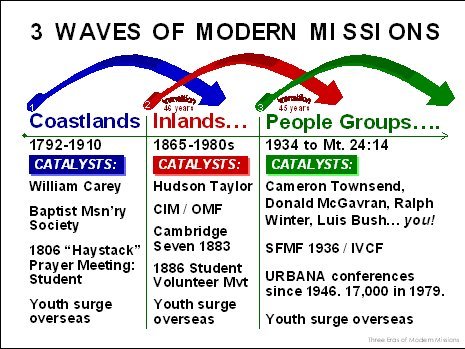
Popularizing field insights
In 1974, to guide believers in embracing God’s global agenda, Ralph Winter distilled insights from this collaborative study of seasoned missionaries into a course that later took a variety of forms:
- “Perspectives on the World Christian Movement” (180,000 alumni)

- Mission Mundial” (has fueled mission vision in Latin America)
- “Kairos” (a global adaptation of Mission Mundial)
- “World Christian Foundations” (an MA program), etc.
Alongside the strategy coordinators who were trained during the 1980s and beyond, alumni of these courses have become like Gideon’s mighty men—revealing God’s power through their disproportionate impact.
By the year 2000, perhaps 1,000 missionaries[19] were pursuing God for movements among UPGs. As God blessed their efforts, they learned from each other’s successes and failures, leading to multiplying movements that today may rival or even surpass first century growth.
Real-life examples
- Ying and Grace were church planters. Each year, they would win 40–60 people to Christ, organize them into a church, then move to a new city. At the end of ten years, if each of these churches had doubled in size, this could have produced 1,200 new believers. Then Ying was asked to take responsibility for an unreached population of 20 million. In the year 2000, Ying and Grace were trained in movement principles and began training disciples to start multiplying ekklesia. Over the next decade, 1.8 million new disciples were baptized and discipled using a discovery Bible study approach, and ekklesia multiplied to 160,000 with an average annual growth rate of 50%![20] The researchers who later verified this movement with a field assessment team found that these numbers had been consistently under-reported.
- Trevor works among a 99+% Muslim people group. He began by identifying local believers with a desire to bless Muslims and a willingness to experiment. He guided these believers to start multiplying small discovery Bible studies that discuss and obey Scripture, and to learn from each other’s successes and failures. Each started a movement of discovery Bible studies, through which Muslim participants consistently come to faith in Christ. By August 2017, relational sharing and natural migration had carried this network of movements to 40 languages in eight countries, yielding a total of 25 full movements and many more movement engagements. As of January, 2018, just five months later, this network had spread to 47 languages in 12 countries![21]
- VC reports: “Many missionaries came to my country but did not see the fruits of their labors. We are privileged to see this fruit. We have gone from evangelism, to disciple making, to church planting, and now to igniting movements. Now we have a team of at two or more families in nearly 50% of my country’s many villages, and feel confident that by 2020 we will have a team in every village!”
Intimacy with God
God reserves a rare depth of fellowship for those who engage in a grand purpose together. Our intimacy with God, and answered prayer, are both tied to bearing multiplying fruit (Jn 15:7–8, 15–16).
Jesus said:
I have called you friends, for everything that I learned from my Father I have made known to you (Jn 15:15).
The writer of Hebrews declared:
God wanted … His purpose very clear to the heirs of what was promised …(Heb 6:17).
Jesus prophesied:
This good news of the kingdom will be preached … as a testimony to all nations … (Mt 24:14).
As we go to disciple all nations (Mt 28:19), we rest in the reality that He is with us to the end of the age (Mt 28:20).
The distribution of multiplying ekklesia remains very uneven. The 24:14 Coalition invites you to help address this injustice.
Let us press in to know the Lord better by joining Him in His pursuit of no place left (Rom 15:23) where Jesus is not yet preached, known, loved and worshiped.[22]
Application
Take these steps toward becoming a reproducing disciple and fueling this now global development:
Engage locally
- Pray persistently for the Holy Spirit to make you a “fisher of men,” one who makes disciples who make disciples.
- Get the free M28 app or visit m28global.org and see the Lord’s guidance in starting such a discoveryBible study that leads others to do the same.

- Read Stubborn Perseverance—a movement manual written as a novel—to understand how discovery Bible study leads to movements, and how your team can pursue one (StubbornPerseverance.org).
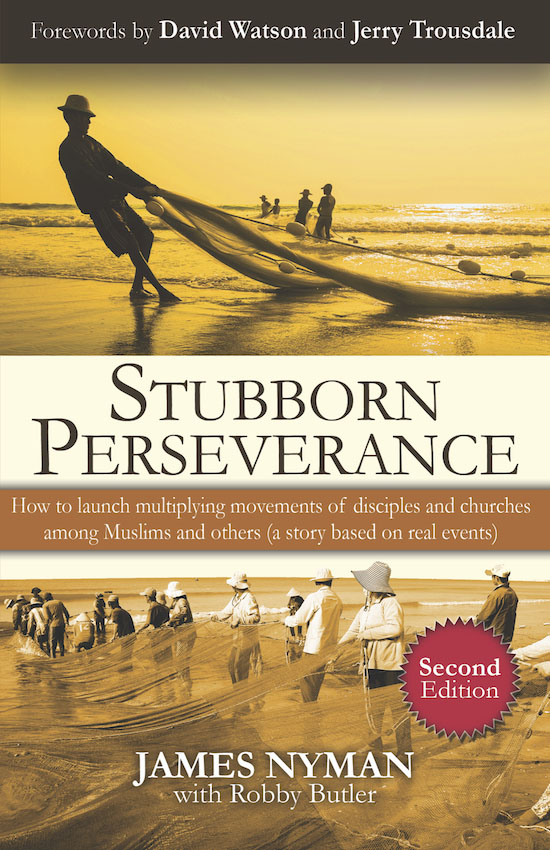
Engage globally
- Pray daily for UPGs, using the Global Prayer Digest (GlobalPrayerDigest.org) and Joshua Project (JoshuaProject.net/pray/unreachedoftheday), both available for daily delivery to your email box or smart phone app.
- Read the Jan/Feb 2018 Mission Frontiers on the 24:14 Coalition (MissionFrontiers.org) and join the 24:14 Coalition (2414Now.net).
- Read No Place Left—a thriller saga (Hastening and Rebirth) of how movements are multiplying globally (NoPlaceLeft2025.org).

- Take the Perspectives course to see how movements fit into the BIG picture of God’s purpose: Perspectives.org (on-line or at a location near you).
Get a free book and join the learning community at Multiplying Movements (MultMove.net).
[1] JoshuaProject.net
[2] Lausanne.org/best-of-lausanne/finishing (Kent leads the mission agency Beyond.)
[3] See the Jan/Feb 2018 Mission Frontiers on the 24:14 Coalition.
[4] Engaged with movement strategy, but not yet reproducing to four generations.
[5] Based on credible reports of 4+ streams replicating to 4+ generations.
[6] Ekklesia is the New Testament Greek word in Jesus’ declaration “I will build my ekklesia” (Mt 16:18). Four English Bibles before the King James translated this word as “assembly,” but the commission for the King James required translators to use “church” instead of “assembly,” apparently to delegitimize gatherings of believers outside the state-owned buildings.
[7] See the “CPM Continuum” at MultMove.net/cpm-continuum
[8] Movement ekklesia tend eventually to produce the visible churches common to Christian lands. Yet premature planting of visible churches through “extraction” evangelism often offends local UPG communities and inhibits movements. See “Indigenous Movements: How Peoples are Reached” at MultMove.net/articles
[9] See the YouTube video Traits of Churches that Multiply
[10] Report from the Center for the Study of Global Christianity, entitled “Table BB. Numerical trends in the worldwide expansion of Christianity, AD 30–AD 2200, with special reference to the 1st century AD.”
[11] ChristianityToday.com/history/issues/issue-1/prayer-meeting-that-lasted-100-years.html
[12] MissionFrontiers.org/issue/article/john-wesleys-church-planting-movement and MissionFrontiers.org/issue/article/the-story-of-movements-and-the-spread-of-the-gospel
[13] Grace.org.uk/mission/enquiry4.html
[14] 2.5% of world population.
[15] 11% of world population.
[16] My estimate is based on published figures for these three movements.
[17] McGavran’s original School of World Mission later opened its doors to aspiring missionaries and became the School of Intercultural Studies.
[18] See “A Church in Every People: Plain Talk about a Difficult Subject” at MultMove.net/church-every-people
[19] My own rough estimate
[20] T4T: A Discipleship Re-Revolution: The Story Behind the World’s Fastest Growing Church Planting Movement and How it Can Happen in Your Community! by Steve Smith (MultMove.net/t4t).
[21] Watch for books “for movement activists” by Trevor.
[22] See the May/Jun 2016 Mission Frontiers on the No Place Left movement.








comments